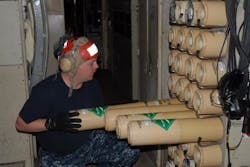Navy bulks-up on submarine-hunting sonobuoys for U.S. and Taiwan maritime security forces
PATUXENT RIVER NAS, Md., 29 Jan. 2012. U.S. Navy anti-submarine warfare (ASW) experts are buying 50,430 AN/SSQ-53F advanced passive sonobuoys from ERAPSCO Inc. in Columbia City, Ind. under terms of a $38.4 million contract modification announced Friday. In this order, 49,990 sonobuoys are for the Navy and 440 are for the Taipei Economic and Cultural Representative Office in Washington, which is the diplomatic representative of Taiwan to the U.S.
The AN/SSQ-53F directional frequency and ranging (DIFAR) sonobuoy, which is dropped from fixed-wing aircraft or helicopters, uses four hydrophones -- each one a multichannel directional piezoelectric ceramic transducer -- that operate at depths of 90, 200, 400, and 1,000 feet to listen for potentially hostile submerged enemy submarines. Aircraft can drop a pattern of sonobuoys, which relay information back to the aircraft by radio link, to determine the exact locations of enemy submarines.
Each sonobuoy is designed to determine the direction from which it can hear submarine noises, so a pattern of sonobuoys can determine a submarine contact's range, bearing, and location by using triangulation. ERAPSCO Inc operates as a joint venture between the Sparton Corp. Defense & Security segment in Le Leon Springs, Fla., and Ultra Electronics USSI in Columbia City, Ind.
Operators of the AN/SSQ-53F can set the operational life of each sonobuoy to 30 minuets, one, two, four, or eight hours. The device automatically scuttles itself eight hours after being deployed. Users also can select the device's DIFAR, constant shallow omni sensor (CSO) or calibrated omni (CO), sensor selection capability, DIFAR automatic gain control (AGC) on/off, and the capability to set one VHF transmitter channel out of 96 available channels.
Users select depth, life, sensor, AGC, and channel selection settings prior to launch, yet may control all settings except the sonobuoy's depth after deployment.
The SSQ-53F has three sensors: a constant shallow omni (CSO), an advanced DIFAR sensor, and a calibrated wideband omni. The buoy digitally conditions and amplifies the acoustics and provides directional data that helps establish azimuthal bearing to the submarines being tracked.
ERAPSCO will do the work on building the sonobuoys in Columbia City, Ind., and De Leon Springs, Fla., and should be finished by January 2014. Awarding the contract were officials of U.S. Naval Air Systems Command at Patuxent River Naval Air Station, Md.
For more information contact ERAPSCO online at http://erapsco.com, Sparton Defense & Security at www.sparton.com, Ultra Electronics USSI at www.ultra-ussi.com, the Taipei Economic and Cultural Representative Office at www.taiwanembassy.org/US, or Naval Air Systems Command at www.navair.navy.mil.

